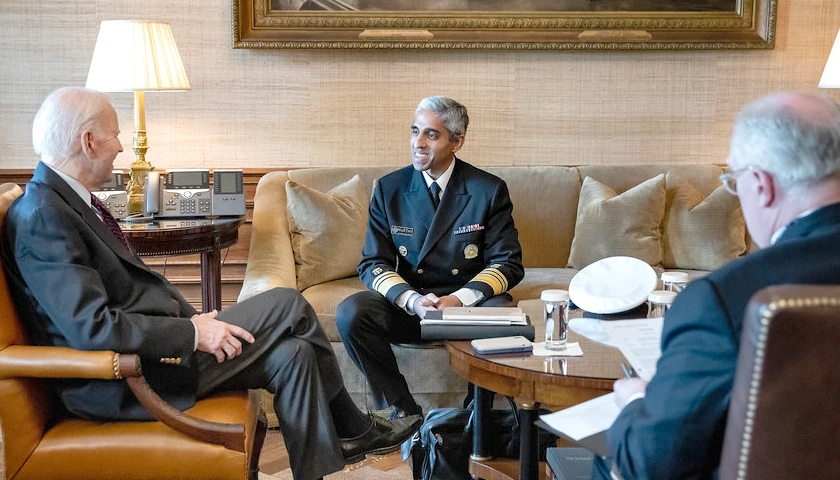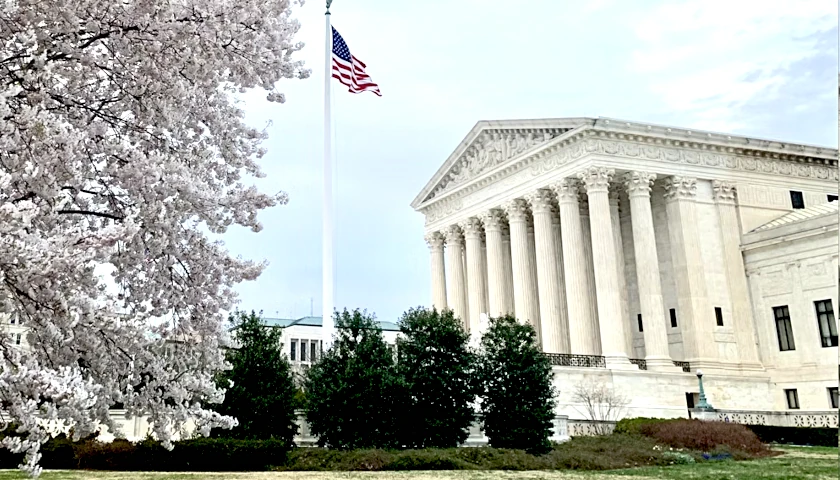by Nate Hochman
Yesterday, Surgeon General Vivek Murthy made headlines by declaring gun violence to be a “public health crisis,” a statement that achieves the impressive feat of being both ludicrous and banal at the same time. The declaration was accompanied by a 40-page report — and a televised, direct-to-camera address from Dr. Murthy himself — “recommending,” as the New York Times reported, “an array of preventive measures that he compared to past campaigns against smoking and traffic safety.”
Perhaps the only thing the surgeon general’s report and accompanying statements were right about is that “gun violence” is, in fact, a major problem in the United States today. After that, however, its relationship to reality quickly disappears. Per the Times, “Dr. Murthy’s 32-page advisory calls for an increase in funding for firearm violence prevention research; advises health workers to discuss firearm storage with patients during routine medical visits; and recommends safe storage laws, universal background checks, ‘red flag’ laws and an assault weapons ban, among other measures.” Notably absent from the list of “solutions” is any meaningful strategy at all to take the people who commit gun violence — i.e., violent criminals — off the streets. (Or even to increase police presence in the places where gun violence happens most frequently). Instead, it is law-abiding gun owners who are expected to foot the bill.
The fact is that gun crime is a major problem in America because crime is a major problem in America, and crime tends to be caused by violent criminals. We used to have a solution for this problem: Law enforcement officers to enforce the law, and prisons to imprison those who broke it. It may come as a surprise to Dr. Murthy and his counterparts, but this approach actually worked quite well, in most places and times, for the past few millennia. An endless stream of studies have all arrived at the shocking conclusion that more police leads to less crime, often by substantial margins. But data isn’t even necessary to come to that conclusion; basic common sense, and a rudimentary understanding of cause and effect, does the trick just fine.
For Dr. Murthy and the phalanx of social scientists who share his political goals, however, it isn’t that simple. The surgeon general “said he saw a public health campaign against gun violence as a similar challenge [to reducing tobacco use], requiring a combination of education and awareness campaigns, culture shifts and policies,” the Times reported. “Guns are not only a health problem,” Jonathan M. Metzl, a professor of sociology and psychiatry at Vanderbilt University, chimed in. “They are a democracy problem and a race problem and a pluralism problem.”
The report itself reflects Dr. Metzl’s enlightened thinking. In a section titled “Socioeconomic, Geographic, and Racial Inequities,” it details the “structural factors that significantly increase the risk of experiencing firearm violence,” which include “poverty, living in an area with low social mobility, or being in a historically marginalized group impacted by structural racism.” Understanding these “social determinants of health,” it writes, are “critical to addressing this public health crisis.” This, of course, was always the purpose of declaring gun violence a “public health” issue in the first place: Shifting the focus away from the source of gun violence — i.e., the people using the guns to commit the violence — and towards an abstract, complex set of interlocking “social determinants” and socioeconomic factors, with a healthy dose of racial grievance layered on top.
You see, crime isn’t actually the result of criminals; it’s a result of social conditions. It’s an education issue, a community funding issue, a racism issue, a public health issue — it’s about anything and everything other than the issue of crime itself. The solution, then, is not to confront the criminals with “force, rooted in justice, and backed by moral courage,” as Pat Buchanan famously put it, but to opt for the remedies that managerial elites offer for every social problem and pathology: More therapeutic programs, more bureaucrats, and more social engineering. More tax dollars will line the pockets of more administrators, both in government and in its parastatal allies in the nonprofit sector; the normal Middle American gun owner will be subjected to simultaneously infantilizing and restrictive new burdens on his right to keep and bear arms; and the violent mayhem on our city streets will persist as it had before, unhindered by a system that was never designed to actually solve the problem in the first place.
At times, one has to wonder why there hasn’t been a revolution in this country. Our ancestors went to war with the British Empire over a stamp tax. By the time Dr. Murthy finished flapping his mouth yesterday, most of them would have already begun to load their muskets.
There is a term that one hears on the Right from time to time: “anarcho-tyranny.” The concept refers to “a kind of Hegelian synthesis of what appear to be dialectical opposites: the combination of oppressive government power against the innocent and the law-abiding and, simultaneously, a grotesque paralysis of the ability or the will to use that power to carry out basic public duties such as protection or public safety” — a dynamic that “not only fails to punish criminals and enforce legitimate order but also criminalizes the innocent.”
This is a constant and essential feature of progressive governance today. In every jurisdiction where the Left claws its way into power, criminals are given free reign while law-abiding citizens are forced to pay for their crimes. One of the most glaring examples of this took place (and continues to take place) in my hometown of Portland, Oregon, where the pandemic produced anarcho-tyranny in its most pristine, textbook form. As I wrote in late 2021:
Portland’s approach to governance over the past two years has been a paradox: an unholy marriage of lax prosecution of real crime and draconian crackdowns against law-abiding small-business owners and citizens. The district attorney for Multnomah County, where Portland is located, declined to prosecute 70 percent of cases related to Black Lives Matter protests last year, and the Portland Police Bureau leaves 911 callers on hold for hours. The city surpassed its all-time annual record for shootings in late September, with three months left to go in the year — and as is often tragically the case, black Portlanders were killed by shootings at twelve times the rate of white Portlanders. After the municipal government effectively stopped enforcing vagrancy laws, the homeless population exploded from about six large encampments to over 100. At the same time, Oregon has consistently led the country in public-health restrictions throughout the pandemic, with Governor Kate Brown routinely forcing businesses to close at unpredictable intervals, even after vaccines became widely available. Oregon’s outdoor mask mandate — which applied to vaccinated and unvaccinated residents alike — was the last remaining in the country, until it was finally repealed at the end of November.
The victims of this arrangement were not the rioters or looters or various other perpetrators of violent crime, but men like Dylan Rogers, a bike shop owner I interviewed for the article who had no choice but to sleep in his business with a shotgun for seven months — only to eventually lose the business anyways. As I observed at the time, “Portland is a shell of its former self. The full cost of social breakdown can’t be measured in crime rates — civic disorder is a spiritual malaise. It is the simmering resentment that comes from knowing that you can work hard, play by the rules, and still be crushed by forces beyond your control. It is the inversion of right and wrong, where criminals are treated with sympathy and victims are portrayed as villains, where sidewalks stretching for blocks are simply ceded to rows of homeless tents.”
Today, much of the nation itself resembles the same description. The same ideological pathologies that hollowed out Rose City are in the national bloodstream, rapidly making their way to the American heart. Perhaps we’re all Portlanders now.
– – –
Nate Hochman is a Writer at The American Spectator. Follow him on X at @njhochman.





